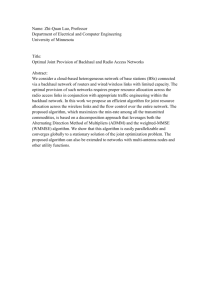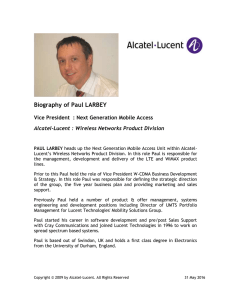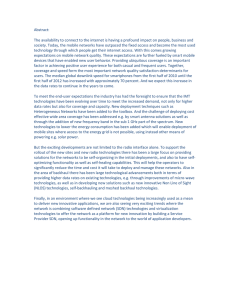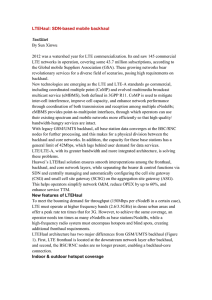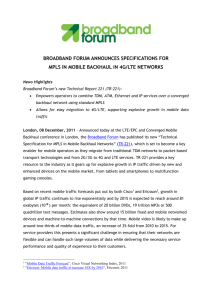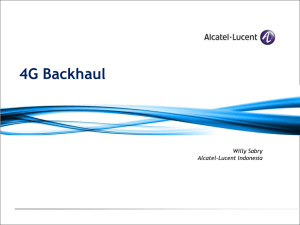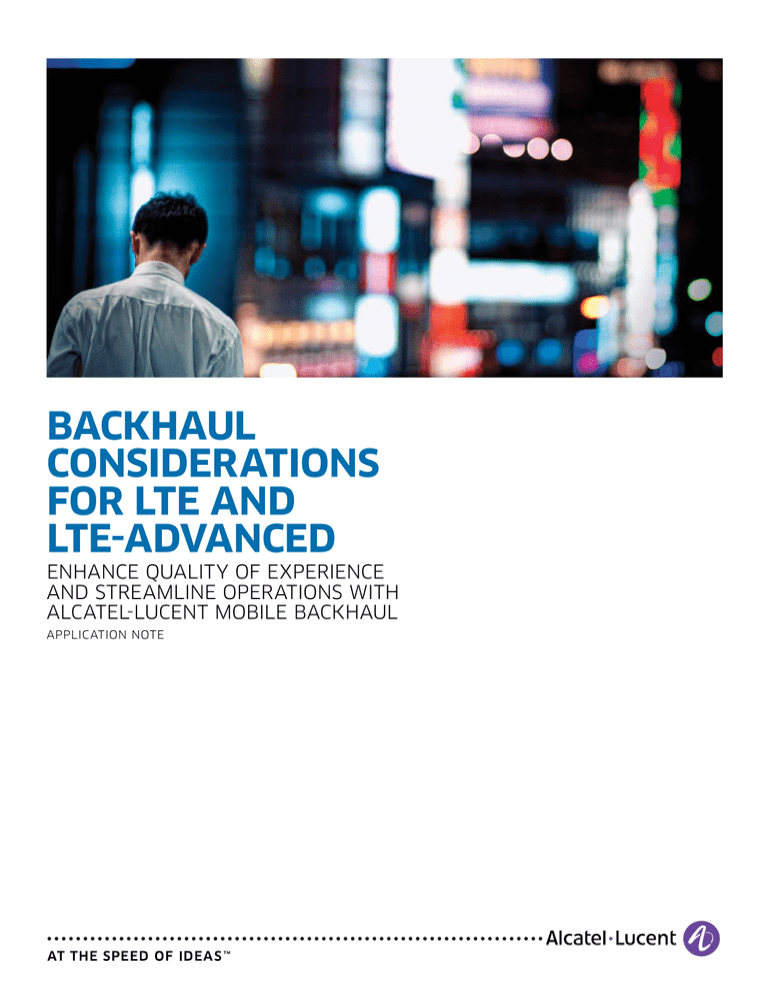
BACKHAUL
CONSIDERATIONS
FOR LTE AND
LTE-ADVANCED
ENHANCE QUALITY OF EXPERIENCE
AND STREAMLINE OPERATIONS WITH
ALCATEL-LUCENT MOBILE BACKHAUL
Application Note
Abstract
The mobile radio access network (RAN) is evolving rapidly, driven by the need to
improve capacity and coverage while keeping capital and operating expenses under
control. As cell sites are rolled out in support of Long Term Evolution (LTE) services,
and the increase in mobile data services continues unabated, bandwidth requirements
will continue to climb. LTE, and particularly LTE-Advanced (LTE-A), bring a number of
enhancements to the radio domain, that will help operators address the growing demand
for bandwidth. However, they also place specific requirements on the backhaul network.
This paper examines the impact of LTE and LTE-A on mobile backhaul networks and
looks at the network requirements these technologies introduce. The Alcatel-Lucent
Mobile Backhaul Solution is described and the utility of its attributes in supporting
efficient LTE and LTE-A deployment is highlighted.
Table of contents
Impact of LTE and LTE-A on Mobile Backhaul
/
1
Overview of Backhaul Requirements
for LTE and LTE-A / 2
Alcatel-Lucent Mobile Backhaul Solution for LTE and LTE-A
/
3
Solution overview / 3
Key solution attributes / 3
Some Deployment Scenarios
/
8
Extending a mobile backhaul deployment / 8
Adding a small cell broadband backhaul deployment / 9
Conclusion
/
9
Appendix: Key products in the Alcatel-Lucent Mobile Backhaul solution
Alcatel-Lucent 7705 Service Aggregation Router
Alcatel-Lucent 7210 Service Access Switch
/
/
Acronyms
/
13
/
11
11
Alcatel-Lucent 5620 Service Aware Manager
10
11
Alcatel-Lucent 9500 Microwave Packet Radio
Alcatel-Lucent 7750 Service Router
/
/
12
/
10
Impact of LTE and LTE-A on Mobile Backhaul
Long Term Evolution (LTE) radio technology is bringing spectral efficiency improvements,
supporting higher traffic volumes, and driving the shift in backhaul architectures to an allIP model. LTE-Advanced (LTE-A) will bring further efficiencies and advanced radio signal
processing techniques to boost throughput still further. Several features are particularly
relevant in defining the incremental architectural and engineering requirements of the
backhaul network as it evolves to support LTE and LTE-A.
• Carrier aggregation delivers higher traffic rates by combining spectral bands, even
if non-contiguous, into a larger aggregated carrier. In combination with higher order
Multiple Input Multiple Output (MIMO) antenna technology, this has the potential to
unlock very high speeds (Gb/s), particularly in the downlink.
• The X2 interface from the eNodeB is a fundamental concept of LTE. The X2 interface
allows meshing to take place directly between eNodeBs. This keeps certain traffic
streams such as Radio Resource Management (RRM) from being unnecessarily directed
to the core and back, thus improving latency and reducing network load. Initially the
X2 interface was rarely activated in real-world LTE environments. However, this is
starting to change as its potential efficiencies are understood and valued.
• Interference mitigation is a technology focus area of LTE-A. The two principal
techniques employed are Enhanced Inter-cell Interference Co-ordination (eICIC)
and Coordinated Multipoint (CoMP). eICIC specifically minimizes interference
between cells, often in a heterogeneous (macro and small cell) network. It does
this by arranging relative power levels in adjacent cells appropriately in real time
to maximize RAN performance. CoMP is a suite of techniques that can be used to
mitigate interference. However, it also enables better utilization of network resources
by leveraging several base stations at once and combining base station power for
improved performance and quality of experience (QoE). The nature of technologies
such as CoMP and eICIC means that close coordination is needed between the base
stations involved.
• Evolved Multimedia Broadcast Multicast Service (eMBMS) provides an efficient
mechanism for the delivery of broadcast and multicast services. While eMBMS was
first defined for LTE, it has been further refined and enhanced for LTE-A. eMBMS
offers more carrier configuration flexibility, higher video resolution services because
of higher LTE bit rates, and a dynamic reservation/release of network resources.
• The emergence of public-access small cells to enhance capacity and coverage is really
a parallel trend to the deployment of LTE and LTE-A rather than something formally
linked to these technologies. However, it is a relevant discussion point here as it is
likely to happen over the same time frame as these technologies are deployed. The
heterogeneous network (or HetNet) consists of both traditional macro cells and small
cells. Small cells are deployed much more densely and in higher quantities, in both
outdoor and indoor urban locations with varied access to backhaul transport facilities.
Backhaul Considerations for LTE and LTE-Advanced
Alcatel-Lucent Application Note
1
Overview of Backhaul Requirements
for LTE and LTE-A
It is important to ensure that the mobile backhaul network is positioned to support and
complement the evolution to LTE and LTE-A. The mobile backhaul network must not be
a barrier to increasing capacity and coverage and to the delivery of an optimal QoE for
the end user as LTE and LTE-A are deployed. The principal requirements include:
• Scalability: The backhaul network must scale smoothly to support increasing numbers
of cell sites at higher capacities. LTE and LTE-A are driving the transition to an all-IP,
any-to-any mobile backhaul network, leveraging MPLS for precise traffic engineering
and IP-optimized transport over a highly scalable Ethernet infrastructure. Network
resiliency is crucial to supporting the subscriber’s QoE. In particular, as more cell sites
home in on higher capacity head-end systems, scalable failure recovery mechanisms
become more critical to limit the breadth of impact should network resources become
unavailable.
• Flexibility: The introduction of a mix of small cells and macro cells in an LTE/
LTE-A environment brings the need to leverage the closest, most cost-effective
backhaul access infrastructure that can meet quality of service (QoS) requirements.
This will result in a greater diversity in backhaul access types, driving a requirement
for more flexible solutions that can operate consistently whether over microwave,
xDSL, Ethernet or GPON. In addition to LTE and LTE-A, support for 2G, 3G, LTE
and Wi-Fi® services is needed. Mobile network operators must be able to provide
appropriate access to network resources, such as link bandwidth, for a range of traffic
streams, especially when networks are operated at high utilization levels. Traffic
streams may include operations, administration and management (OAM); telemetry;
streaming video; and voice over Internet Protocol (VoIP). Maintaining frequency
synchronization has always been a requirement in networks generally and particularly
in mobile. This will continue. LTE and LTE-A in particular also demand accurate
phase synchronization to support video broadcast, interference management and time
division duplexing for example.
• Simplicity: Simplified operations are required to minimize the total cost of ownership
(TCO) and permit efficient network deployment, administration and maintenance.
A standardized approach to cell site backhaul provisioning and turn-up is required,
regardless of access type or location. The need for site visits must be minimized. Endto-end visibility and control of elements at every cell site (macro and small) is needed
for streamlined OAM, with surgical remote troubleshooting. It is crucial that the
network actively indicate when key performance indications (KPIs) are out of bounds
and service level agreements (SLAs) are not being met.
These requirements for LTE and LTE-A backhaul build upon the existing requirements
for 2G, 3G and Wi-Fi backhaul. The Alcatel-Lucent Mobile Backhaul solution is targeted
at meeting these requirements and provides a solid business foundation for efficient
growth. The solution incorporates:
• Service-rich IP routing, leveraging MPLS for determinism and traffic engineering
• IP-optimized transport over a highly scalable Ethernet infrastructure
Backhaul Considerations for LTE and LTE-Advanced
Alcatel-Lucent Application Note
2
Alcatel-Lucent Mobile Backhaul Solution
for LTE and LTE-A
Solution overview
The Alcatel-Lucent Mobile Backhaul solution is comprised of a suite of products, and is
complemented by Alcatel-Lucent professional services. The principal product elements
are the Alcatel-Lucent 7705 Service Aggregation Router (SAR), the 7210 Service Access
Switch (SAS), the 9500 Microwave Packet Radio (MPR), the 7750 Service Router (SR)
and the 5620 Service Aware Manager (SAM).
Figure 1. Alcatel-Lucent Mobile Backhaul solution
End-to-end Service Aware Management (5620 SAM)
BROADBAND
AND ETHERNET
7705 SAR
7210 SAS
GPON/xDSL
metro Ethernet
INDOOR SMALL CELL
7750 SR
7705 SAR-H
Controllers/
gateways
9500 MPR-e
9500 MPR-s
(NLOS)
9500 MPR
MICROWAVE
7705 SAR
Metro
aggregation
and transport
9500 MPR-s
(LOS)
7705 SAR
7210 SAS
7705 SAR
CPRI FRONTHAUL
7705 SAR
7705 SAR-O
Key solution attributes
The Alcatel-Lucent Mobile Backhaul solution leads the industry in its ability to deliver
scalable, flexible and simplified backhaul networking while ensuring the resiliency, QoS
and network synchronization required to support the evolution of the RAN to LTE and
LTE-Advanced.
Backhaul Considerations for LTE and LTE-Advanced
Alcatel-Lucent Application Note
3
BBU
Scalability
The number of cell sites to be supported in a single backhaul network will continue to
expand. Some of the largest backhaul networks may see expansion from tens of thousands of cell sites to potentially hundreds of thousands of sites. Each one of these sites
will also see an increase over time in the amount of bandwidth required, which in turn
will drive the requirement for increased bandwidth back into the backhaul network.
The Alcatel-Lucent 7750 SR provides a highly reliable head-end aggregation and concentration point for thousands of small cell and/or macro cell sites over any intermediate
transport. The 7750 SR, with its revolutionary FP3 network processor, provides comprehensive resiliency and massive, proven scaling for tens of thousands of cell sites. The
7750 SR supports high-density 10, 40 and 100 Gb/s interfaces, ensuring ample capacity
to accommodate future growth as the deployment of LTE and LTE-A broadens.
New topology requirements are emerging to respond to:
• The need to connect more and more cell sites
• The potential to connect cell site to cell site (such as for the LTE X2 interface)
• The need for connectivity back to the controller site
Existing networks built on traditional point-to-point and tree architectures become
less able to meet the emerging scale and reliability requirements in a cost-effective
manner. New architectures including ring and mesh architectures will help, and IP/
MPLS networking becomes crucial in order to provide traffic engineering and resiliency
mechanisms.
The Alcatel-Lucent solution supports both eICIC and CoMP, to allow for increased spectral efficiency and system resource usage via the mitigation of inter eNodeB interference.
The solution also enables the necessary low latency connectivity that these capabilities
require, either via the use of routing over high bandwidth interfaces and/or front-haul
CWDM fiber connectivity.
Scaling resiliency
Networking resiliency is built into the Alcatel-Lucent product portfolio: it is part of the
foundational architecture of the Service Router Operating System (SR OS) software. The
solution brings a strong suite of traffic engineering and resiliency capabilities via features
such as control and switch fabric redundancy, Fast Reroute and redundant pseudowires
that can ensure end-to-end reliability across both leased and self-built mobile backhaul
environments.
Backhaul Considerations for LTE and LTE-Advanced
Alcatel-Lucent Application Note
4
The 7705 SAR operates in conjunction with 7750 SRs at the head-end — in a central
office or mobile telephone switching office (MTSO) — as shown in Figure 2. If an
event occurs to compromise access to one of the 7750 SRs, the 7705 SARs will rapidly
re-converge traffic on the remaining device. These kinds of advanced features have been
verified at high scale in independent test labs and in large deployments in real networks.
Without these sophisticated mechanisms, it could be possible to lose traffic from tens of
thousands of small sites for an extended period of time following a maliciously triggered
or accidental failure.
Figure 2. Providing resiliency for cell site backhaul
MTSO
Thousands of
macro cells
7705 SAR
Backhaul
infrastructure
X
7750 SR
7750 SR
Controllers/
gateways
Tens of thousands
of small cells
7705 SAR
Flexibility
There is a great variety of installation types in small (and macro) cell sites and a range of
uplink media that can be used, depending on availability, suitability and cost. As a result,
operational flexibility is a key attribute of any mobile backhaul deployment.
Media flexibility
A powerful aspect of the solution is the ability to provide a consistent networking and
operational capability over a wide range of physical media types. Due to the pervasive
nature of mobile backhaul networks, varied media types are often encountered, at a
range of cost points, throughout the network. The flexibility to select the most cost-effective backhaul media available in a particular site — while meeting service requirements
— is a key competitive advantage. Some carriers may choose initially to deploy microwave backhaul to expedite the provision of coverage. This microwave equipment may
stay in place, or be enhanced with higher capacity systems as the technology evolves.
Alternatively, as fiber is made available at a particular location, this may take the place
of microwave, creating an opportunity for re-deployment of the microwave equipment.
This adjustment of equipment can be carried out with no impact to the networking layer
or to ongoing operations. The ability to leverage PDH/SDH and SONET infrastructures
also allows maximum depreciation of existing assets while the solution provides a clear,
controlled path to a modern packet infrastructure.
Backhaul Considerations for LTE and LTE-Advanced
Alcatel-Lucent Application Note
5
The 7705 SAR products can leverage the appropriate transmission media and any underlying network infrastructure for further backhaul deeper into the aggregation network.
Wireline access options (such as point-to-point fiber, GPON and bonded xDSL) as well
as Line of Sight (LOS) wireless provide the best QoS performance for backhaul. Non Line
of Sight (NLOS) wireless options may also be considered where the other access options
are not available or where QoS requirements are relaxed. The Alcatel-Lucent 9500 MPR
portfolio includes a range of unlicensed/lightly-licensed products (the 9500 MPR-s)
optimized for accelerating small cell deployments. These include sub-6 GHz radios for
point-to-point and point-to-multipoint NLOS applications and 60 GHz radios for highcapacity, short-reach point-to-point applications.
Carrier Ethernet or IP VPN services can also be used for backhaul infrastructure, either
from a separate backhaul transport provider or from the wireline services arm of a fully
converged operator.
Networking and topology flexibility
The Alcatel-Lucent Mobile Backhaul solution supports a rich suite of Layer 2, 2.5 and
Layer 3 switching and routing capabilities to allow the most appropriate and efficient
networking technology to be deployed. From cell site to head-end, point-to-point connections such as pseudowires can co-exist with full IP routing including IPv6. VPN options
allow OAM traffic to be segregated from user bearer traffic for example. Providing a full
routing capability allows the LTE X2 interface to be routed locally if desired for more
efficient use of backhauling resources. The ability to build specific IP VPN instances for
X2 interfaces on neighbor groups of eNodeBs is architecturally useful. This can help to
contain the need for backhaul bandwidth, which can help lower operating costs. From a
topology standpoint, operators can save bandwidth and boost reliability by aggregating
downstream devices in a daisy chain or ring.
eMBMS enables the operator to deliver broadcast and multicast video services efficiently.
First defined for LTE, eMBMS has been further refined and enhanced for LTE-A. An available IP multicast capability implemented in the backhaul network (including the 7705 SAR)
can greatly assist the efficient and flexible delivery of broadcast and multicast services.
End-to-end QoS flexibility
Operators must be able to control and maintain QoS for packet traffic. Not all types of
traffic have the same set of requirements. Voice traffic in particular requires low latency
and jitter (latency variation) as well as low loss. Data traffic often has less stringent delay
requirements but may be very sensitive to loss, as packet loss can seriously constrain
application throughput. To offer the required treatment throughout the network, traffic
flows with different requirements are identified and marked in-line with
the appropriate QoS metrics.
LTE supports the concept of a QoS Class Identifier (QCI). The QCI is associated with
each bearer, or IP flow, between the user mobile equipment and the Evolved Packet Core
(EPC). This allows the required resources for the defined service class characteristics to
be made available in the radio network. Additionally, the scheduling functionality in the
eNodeB utilizes the QoS information for offering fair treatment to packets towards the
Backhaul Considerations for LTE and LTE-Advanced
Alcatel-Lucent Application Note
6
radio interface. To respect the required service level in the backhaul network, the QCI
value must be mapped to the packets transmitted from the eNodeB and the EPC. This
mapping and marking of flows at entry to the backhaul network allows the required traffic treatment to be applied at all resource contention points as that traffic passes through
the backhaul network.
Products in the Alcatel-Lucent Mobile Backhaul solution use extensive traffic management policies to ensure fairness. Detailed classification and hierarchical scheduling
options include: queue type-based, weighted round robin or strict priority and profiled
scheduling. Multi-tier policing is also available to differentiate and prioritize individual
services and flows. With the solution, operators can differentiate multiple traffic streams,
which in turn enables them to meet the different QoS needs of various traffic types
including OAM, synchronization, site telemetry, streaming video, VoIP and bulk data.
The 7705 SAR in particular has the ability to buffer and shape traffic in order to absorb
transient traffic bursts and improve effective application throughput. This helps operators
deliver an optimal QoE for mobile subscribers.
Synchronization flexibility
Cell sites may rely on the mobile backhaul network to deliver a stable reference from
which to derive radio frequencies and to ensure reliable subscriber handover between
cells. There are a number of features of LTE and LTE-A that require progressively more
accurate phase (and time of day) synchronization. Time division duplex mode
LTE (TD-LTE), eMBMS and CoMP all fall into this category.
The Alcatel-Lucent Mobile Backhaul solution supports a full suite of synchronization
options including line timing, adaptive clock recovery (ACR), differential clock recovery,
synchronous Ethernet and also timing distribution using 1588v2. 1588v2 Master Clock,
Boundary Clock, Transparent Clock, and Ordinary Clock are all supported for frequency,
phase and time of day. Accuracy and high performance timing for packet solutions,
such as ACR and 1588v2, are accomplished by a combination of built-in architectural
features, efficiently tuned algorithms, and powerful QoS mechanisms to minimize
the delay experienced by synchronization traffic. Management of the synchronization
distribution infrastructure is a key differentiating capability. The 5620 SAM provides tools
for managing synchronization, providing centralized synchronization path visualization,
proactive monitoring and alarm correlation to allow rapid discovery, and correction of,
synchronization impairments.
Simplicity of operations
Keeping the cost of operations low has a major impact on the TCO of a network. The
Alcatel-Lucent 5620 SAM is the overarching management entity for end-to-end wireless domain management. The 5620 SAM provides comprehensive support for Fault,
Configuration, Accounting, Performance and Security management. Operations are simplified and streamlined by leveraging a common SR OS software base across the products
in the solution, and by taking advantage of the 5620 SAM’s service aware management
capabilities. With emerging heterogeneous networks, cell site devices will be deployed
in huge numbers. It is therefore vital that operators be able to turn up services remotely
and troubleshoot with minimal site visits.
Backhaul Considerations for LTE and LTE-Advanced
Alcatel-Lucent Application Note
7
End-to-end management is a key strength of the Alcatel-Lucent solution. Operators can
monitor backhaul KPIs and maintain SLA guarantees with the 5620 SAM, in conjunction
with the embedded OAM functionality in the network equipment. At the service layer,
Y.1731 provides OAM support for loss, delay and jitter measurements. At the Ethernet
layer, 802.3ah EFM support is provided and at both the IP and the MPLS layers, a wide
variety of options are available. These functions are all supported throughout the IP/
MPLS product portfolio. Furthermore, the Alcatel-Lucent 5620 Service Assurance Agent
(SAA) can be used to minimize operator workload by proactively probing the delay, jitter
and loss that each service experiences periodically.
Automatic Discovery and Provisioning features provide automated bring-up and template
provisioning capabilities, greatly reducing the workload required to commission new
small cell networks. It also provides a complementary foundation for self-organizing
network (SON)-related features.
Some Deployment Scenarios
Extending a mobile backhaul deployment
A number of large tier 1 operators, particularly in the Americas region, are extending an LTE
macro cell capability to include a small cell deployment to enhance capacity and coverage.
Figure 3. Extending a macro cell mobile backhaul deployment
MTSO #1
LTE small cell
LTE small cell
LOS/
NLOS
Macro cell site
eNodeB,
BTS
MTSO #2 – EPC
LOS/
NLOS
Carrier
Ethernet
7750 SR #1
7705 SAR
7705 SAR
7705 SAR
IP core
SGW
EXTEND
7750 SR #2
One approach to extending a mobile backhaul deployment is for a 7705 SAR-8 or
7705 SAR-M at the macro site to be used to concentrate daisy-chained small sites. The
established macro backhaul solution can be extended to the small cells using 9500 MPR-s
LOS, NLOS, or near line of sight (nLOS) microwave solutions.
The 7705 SAR-8 at the macro site aggregates multiple small cells and the macro cell
traffic, leveraging Layer 2 Carrier Ethernet service to the MTSO. The Carrier Ethernet
service can be provided on products such as the 7210 SAS to deliver IP-optimized packet
transport to the MTSO. The 7705 SAR-8 provides Layer 3 routing at the macro site to
reduce X2 latency and backhaul bandwidth for local small-to-small and small-to-macro
cell handovers. For example, a 7705 SAR-W can be deployed at the small cell site to
enable consistent end-to-end operations and the delivery of resilient Layer 2 and/or
Layer 3 services.
Backhaul Considerations for LTE and LTE-Advanced
Alcatel-Lucent Application Note
8
MME
EPC
PGW
The 7705 SAR-W at the small cell site accommodates future growth and provides
operational simplicity. New frequency bands or services (for example, LTE-Advanced,
Wi-Fi) can be easily added. Expansion to include additional small cell sites is also
straightforward.
Adding a small cell broadband backhaul deployment
In many parts of the world and particularly in Western Europe and Asia, operators want
to leverage fiber assets for mobile backhaul.
Figure 4. Adding a small broadband backhaul deployment
LTE, 3G/HSPA
small cell
MTSO #1
MTSO #2 – EPC
GPON provider network
7705
SAR
GPON
Optical splitter
OLT
Carrier Ethernet
7750 SR #1
IP core
SGW
GPON provider
IP core
7750 SR #2
Many operators use GPON technology to allow for improved scale for broadband
backhaul over fiber. GPON termination as an ONT is available on the 7705 SAR. This
can supply line synchronization and provide line reach up to 20 km. The 7705 SAR-W
at a small site enables end-to-end operations in Layer 2 or Layer 3 services, resiliency
and OAM. The solution can leverage Carrier Ethernet to provide IP-optimized packet
transport to the MTSO.
Integrated PON uplinks are available on the 7705 SAR access platforms. Macro and
small cell backhaul via SHDSL, 8-pair bonded ADSL2+ and 8-pair bonded VDSL2 is also
available as an integrated option within the 7705 SAR portfolio. These additional options
make it possible for operators to leverage existing wireline assets for backhaul.
Conclusion
The Alcatel-Lucent Mobile Backhaul solution delivers a strong set of features and capabilities to support the evolution to LTE and LTE-Advanced. The solution also efficiently
supports 2G, 3G and Wi-Fi backhaul as required. The trends toward Fixed-Mobile
Convergence and IP transformation are enabled and augmented. The solution supports
massive scalability to address continuing growth. It provides operators with flexible
deployment models to address the heterogeneity of operational environments that are
rapidly becoming the norm, and it delivers operational simplicity through streamlined
network and service management.
Backhaul Considerations for LTE and LTE-Advanced
Alcatel-Lucent Application Note
9
MME
EPC
PGW
The overriding attributes of the solution are that it provides the best possible user QoE
in conjunction with the lowest backhaul TCO to enable services providers and their
subscribers to fully benefit from LTE and LTE-Advanced technology enhancements.
Appendix: Key products in the
Alcatel-Lucent Mobile Backhaul solution
The latest information on the key products in the Alcatel-Lucent Mobile Backhaul solution can be obtained from the product websites:
• Alcatel-Lucent 7705 Service Aggregation Router
• Alcatel-Lucent 7210 Services Access Switch
• Alcatel-Lucent 9500 Microwave Packet Radio
• Alcatel-Lucent 7750 Service Router
• Alcatel-Lucent 5620 Service Aware Manager
The following sections also provide brief overviews of the product features and options,
illustrating how these products can be used to deliver mobile backhaul services.
Alcatel-Lucent 7705 Service Aggregation Router
The 7705 SAR portfolio is optimized for multiservice adaptation, aggregation and routing,
especially onto a modern Ethernet and IP/MPLS infrastructure. At small cell sites, compact and rugged 7705 SAR variants such as the 7705 SAR-W and 7705 SAR-H are typically
deployed, adapting traffic to the available uplink media. The 7705 SAR-W is the world’s
first outdoor, compact small cell router, fully environmentally hardened, supporting a
suite of integrated media uplink options to allow efficient deployment wherever coverage
and/or capacity are needed. At larger, clustered, small sites such as a rail station or sports
arena, variants such as a 7705 SAR-M or 7705 SAR-8 could be used.
At macro cell sites, 7705 SAR variants are deployed for many of the pragmatic reasons
encountered at the small site. However, at macro sites, multiple access technologies and
instances are often encountered in interfacing to various types and generations of radio
base stations. Scaling requirements are higher and modularity is increasingly of value at
macro locations. For this reason, products such as the 7705 SAR-M and 7705 SAR-8 are
often deployed, leveraging their modular and scalable architectures. The 7705 SAR-8
also brings redundancy of control plane and switch fabric, an important consideration
when supporting multiple macro and small sites on one platform. The 7705 SAR-O is
an environmentally hardened, fan-less optical add-drop multiplexer. It is an ideal
solution for network operators with access to fiber facilities who want to increase the
value and efficiency of their optical infrastructure by, for example, delivering front-haul
capability for remote radio heads. At higher points of concentration, the larger form
factor 7705 SAR-18 can provide increased levels of traffic aggregation plus support for
multiple macro sites. The 7705 SAR-18 supports 16 slots for user interface cards plus
redundancy of control plane and switch fabric.
Backhaul Considerations for LTE and LTE-Advanced
Alcatel-Lucent Application Note
10
Alcatel-Lucent 7210 Service Access Switch
The 7210 SAS portfolio of compact Ethernet access and aggregation devices enables
Carrier Ethernet transformation across the service access network. It is optimized to
deliver high-value, Carrier Ethernet demarcation in support of business networking
services or mobile cell site gateway applications and to extend the reach of Ethernet and
MPLS-enabled Carrier Ethernet aggregation into smaller network locations. The 7210 SAS
family has nine options for customer edge business and mobile access applications, and
for business, mobile and residential service aggregation applications in the service access
network.
The 7210 SAS-T is a 10Gig Ethernet access device providing demarcation for SLA-based
Virtual Private LAN Services (VPLS) and Virtual Leased Line (VLL) services managed to
the customer edge, and providing 10Gig Ethernet aggregation in smaller network locations. The 7210 SAS-D is an Ethernet access device providing demarcation for SLA-based
VPLS and VLL services managed to the customer edge. The 7210 SAS-E is an Ethernet
access device providing demarcation for VPLS and VLL service delivery in multi-tenant
offices. The 7210 SAS-M is an MPLS-enabled access device providing a common platform
for SLA-based VPLS, VLL, circuit emulation services, IP VPN and enhanced Internet
services managed to the customer edge. For smaller network locations, it also provides
IP/MPLS service aggregation and supports provider edge functionality to consolidate
customer edge routers in IP VPN and Internet service delivery. The MPLS-enabled 7210
SAS-X, with support for a larger number of service queues, packet buffers, label switched
paths, media access control addresses and routing table entries, is designed for more
service-intensive IP/MPLS service aggregation and provider edge functionality for IP VPN
and Internet service delivery in smaller network locations.
Alcatel-Lucent 9500 Microwave Packet Radio
Alcatel-Lucent offers a full portfolio of packet microwave solutions for both macro cell
and small cell backhaul. The 9500 MPR family offers solutions for tail, hub and aggregation sites, across a full range of licensed frequencies (6-42 GHz, 80 GHz), and with full
support for both TDM and packet-based traffic. The 9500 MPR portfolio also includes
a range of unlicensed/ lightly-licensed products (the 9500 MPR-s), optimized for
accelerating small cell deployments, including sub-6 GHz radios for point-to-point and
point-to-multipoint NLOS applications and 60 GHz radios for high-capacity, short-reach
point-to-point applications.
Alcatel-Lucent 7750 Service Router
The Alcatel-Lucent 7750 SR multiservice edge routers have been designed from inception
to deliver differentiated, high performance, high availability services. The 7750 SR offers
platform capacities ranging from 90 Gb/s to 4.8 Tb/s and beyond, specialized serviceaware application processing, advanced QoS, and a comprehensive range of Ethernet
and multiservice interfaces and protocols. It provides the kind of scale and intelligence
operators need to deliver residential, business and wireless broadband IP services on a
converged edge routing platform.
Backhaul Considerations for LTE and LTE-Advanced
Alcatel-Lucent Application Note
11
The 7750 SR integrates the scalability, resiliency and predictability of MPLS along with
the bandwidth and economics of Ethernet and a broad selection of legacy interfaces.
These features enable a converged network infrastructure for the delivery of nextgeneration services. With its advanced and comprehensive feature set, the 7750 SR
can be deployed as a:
• Broadband Network Gateway for residential services
• Multiservice Edge for Carrier Ethernet and IP VPN business services
• Mobile packet core for 2G, 3G, Wi-Fi, LTE and LTE-Advanced wireless networks
• High-capacity aggregation router in mobile backhaul applications
In a mobile backhaul application, the 7705 SR is often deployed at the highest levels of
aggregation. At the head-end, the 7750 SR provides the hand-off to the RAN controllers
while delivering comprehensive resiliency and massive, proven scaling for any networking paradigm.
Alcatel-Lucent 5620 Service Aware Manager
The 5620 SAM takes operators well beyond the traditional boundaries of element,
network and service management. The 5620 SAM enables end-to-end management of
the all-IP network to help operators quickly gain the efficiencies they need to beat the
competition.
From access to core, fast and easy provisioning reduces time to market and increases
flexibility when launching new services. Proactive troubleshooting helps resolve problems before they affect customers, and ease of integration within the existing operational
environment helps operators get the most from their investments.
In a mobile backhaul application, the 5620 SAM provides unified element, network and
service management, so operators have complete visibility of network operations and
control between the cell site and the controller site. The 5620 SAM, in conjunction with
the 7705 SAR as a universal cell site access and routing device, also enables operators to
more quickly and efficiently roll out new cell sites, and more easily manage the ongoing
OAM of the mobile backhaul infrastructure.
Key 5620 SAM features include:
• Easy-to-use GUI that accelerates configuration and provisioning tasks. Automation
further accelerates tasks and minimizes the time and costs associated with the errors
that commonly occur when a command-line interface is used.
• Common provisioning for Layer 2 and Layer 3 services to reduce the cost of delivering
different service types
• Extensive service assurance capabilities that allow proactive identification of problems
before they affect customers
• Powerful troubleshooting tools that help operators quickly pinpoint the root cause of
problems to speed resolution
• Templates that allow simplified integration with existing processes and workflows
• Open interfaces that enable integration with custom web portals, Operations Support
Systems, and Business Support Systems.
Backhaul Considerations for LTE and LTE-Advanced
Alcatel-Lucent Application Note
12
Acronyms
5620 SAM
Alcatel-Lucent 5620 Service Aware Manager
5620 SAA
Alcatel-Lucent 5620 Service Assurance Agent
7210 SAS
Alcatel-Lucent 7210 Service Access Switch
7705 SAR
Alcatel-Lucent 7705 Service Aggregation Router
7750 SR
Alcatel-Lucent 7750 Service Router
9500 MPR
Alcatel-Lucent 9500 Microwave Packet Radio
CoMP
Coordinated Multipoint
CPRI
Common Public Radio Interface
CWDM
Coarse Wavelength Division Multiplexing
DSL
Digital Subscriber Line
eICIC
Enhanced Inter-cell Interference Co-ordination
eMBMS
Evolved Multimedia Broadcast Multicast Service
eMBMS
Evolved Multimedia Broadcast Multicast Service
EFM
Ethernet (in the) First Mile
EPC
Evolved Packet Core
GPON
Gigabit-capable Passive Optical Network
GUI
graphical user interface
HetNet
Heterogeneous network
HSPA
High Speed Packet Access
KPI
key performance indicators
LOS
line of sight
LTE
Long Term Evolution
MIMO
Multiple Input Multiple Output
MTSO
Mobile Telephone Switching Office
nLOS
Near line of sight
NLOS
Non line of sight
OAM
operations, administration and management
OLT
optical line termination
PDH
Plesiochronous Digital Hierarchy
PGW
Packet Data Network Gateway
PON
Passive Optical Network
QCI
QoS Class Identifier
QoE
quality of experience
QoS
quality of service
RAN
radio access network
SDH
Synchronous Digital Hierarchy
SGW
serving gateway
SLA
service level agreement
SON
self-organizing network
SR OS
Alcatel-Lucent Service Router Operating System
TCO
total cost of ownership
TD-LTE
time division duplex mode LTE
VLL
Virtual Leased Line
VoIP
Voice over IP
VPLS
virtual private LAN service
VPN
virtual private network
www.alcatel-lucent.com Alcatel, Lucent, Alcatel-Lucent and the Alcatel-Lucent logo are trademarks of
Alcatel-Lucent. All other trademarks are the property of their respective owners. The information presented
is subject to change without notice. Alcatel-Lucent assumes no responsibility for inaccuracies contained herein.
Copyright © 2013 Alcatel-Lucent. All rights reserved. NP2013072037EN (August)

